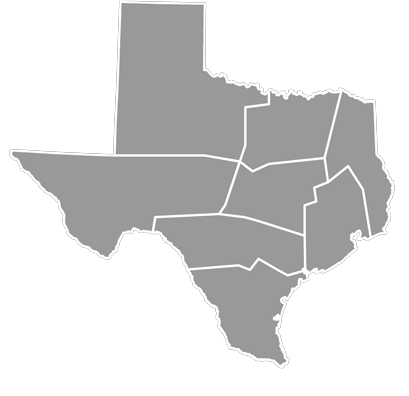Frances Tarlton “Sissy” Farenthold
Image from the Legislative Reference Library Born: 1926 (in Corpus Christi) Noted For: Frances “Sissy” Tarlton Farenthold is noted as a former Texas legislator, a two-time candidate for Texas [...]
Welcome to Count Her In, an interactive exploration of the surprising role Texas plays as a forerunner in the Suffragist Movement. Here you’ll find a timeline of historic milestones, the stories of the women and organizations who pushed for voting equity, and find the inspiration to support our ongoing efforts in women’s rights. Please check back regularly as we continue to add new stories and insights into this very important issue.









 PANHANDLE
PANHANDLE
 HOUSTON
HOUSTON
 EAST TEXAS
EAST TEXAS
 SOUTH TEXAS
SOUTH TEXAS
 NORTH TEXAS
NORTH TEXAS
 SAN ANTONIO
SAN ANTONIO
 AUSTIN
AUSTIN
 WEST TEXAS
WEST TEXAS
There's perhaps no better way to connect with the people and events that changed the course of history than visiting a historical location in person (or “visiting” one online). In honor of the 19th Amendment's 100th anniversary, here's a bucket list of Texas locations with relevance to voting rights that are well worth exploring:
Southeast corner of 11th Street and Congress Avenue in Austin, TX
This marker is located at the former site of the second Travis County Courthouse, where Austin-area women gathered to register for vote for the first time in Texas history in 1918.
613 W 32nd Street / Austin, TX / 78705
Jane McCallum, a prominent Texas suffrage leader and columnist for the Austin American-Statesman, lived in this house with her husband and her five children. She later became the only Texas Secretary of State to serve two terms under two governors.
300 Comal Street / Austin, TX 78702
On this site in the 1940s, a collaboration known as the Pan American Roundtable organized an education program to help Mexican-Americans become eligible to vote as citizens. The program eventually relocated to what is today the A.B. Cantu/Pan American Recreation Center, and the original site was dedicated as a small park that's also a destination on Austin's Tejano Walking Trail. Comal Park is known for its colorful archway, neighborhood basketball court, and beautiful trees.
100 East Sabine Street / Carthage, TX / 75633
As one of the first woman newspaper editors in Texas, Margie Neal used her paper to raise awareness for the cause of voting rights for women. Among other firsts, she later became the first woman to register to vote in Panola County and the first woman elected to the Texas Senate. A historical marker in the town square of Carthage, Margie's hometown, notes her contributions to voting rights and women's rights in Texas.
100 South Houston Street / Dallas, TX / 75202
This marker at the site of the former Dallas County Courthouse honors significant moments in the Dallas and statewide suffrage movement
Fair Park is located immediately east of downtown Dallas near the intersection of Interstate 30, Interstate 45, and Highway 75.
Fair Park was the site of a Woman's Congress held during the earliest days of the suffrage movement, as well as multiple “Suffrage Days” held during the State Fair of Texas. Dallas suffrage leaders and clubwomen also organized a large canteen housed at Fair Park that provided hospitality to World War I servicemen training in Dallas.
2618 Warren Avenue / Dallas, TX / 75215
Juanita Craft was a noted civil rights leader who was also the first African-American woman to vote in Dallas County. During her lifetime, her house was visited by the likes of Thurgood Marshall, Lyndon B. Johnson, and Jimmy and Rosalynn Carter.
Texas Woman's University (Blagg-Huey Library)
The Texas Women's Hall of Fame celebrates the life and achievements of extraordinary Texas women who have made significant contributions in a number of fields, including suffragist and civil rights leader Christia Adair, Lila Cockrell (the first woman mayor of a major American city), Annette Straus (first woman mayor of Dallas), Susan Combs (the first woman agriculture commissioner), and Alicia Chacón (the first Mexican-American woman to serve on the El Paso City Council).
2000 Texas Avenue / El Paso, TX / 79901
Organized in 1981 in response to a two-year strike of women garment industry workers, La Mujer Obrera is a community empowerment organization working to transform conditions for immigrant and Mexican-American women in El Paso and throughout Texas. Voter education and engagement are among the mobilization strategies of the organization, which is also a part of the Equal Voice Network, an El Paso civic engagement coalition.
2317 Texas Avenue / El Paso, TX / 79901
In 1924, Dr. Lawrence Smith, a founding officer of the El Paso NAACP, attempted to vote in the Democratic primary in the East El Paso Fire Station (No. 5). Despite his eligibility, he was turned away because the Texas Democratic primary was open to whites only—four years after the passage of the 19th Amendment granting voting rights to women, and 54 years after the 15th Amendment prohibited denial of voting rights based on race. Dr. Smith and the NAACP challenged Texas's white primary law in two subsequent U.S. Supreme Court cases that paved the way for the law's ultimate demise in the 1940s. The building where he tried to vote is no longer in use as a fire station, but still stands today.
Another El Paso location related to voting rights is the McCall Neighborhood Center, a historic building that was once home to El Paso's first African-American woman high school principal. Today is houses a historical marker and artifact display related to Dr. Smith and other El Paso civil rights figures.
1004 South Church Street / Georgetown, TX / 78626
Jessie Daniel Ames was a noted state suffrage leader and the first president of the Texas League of Women Voters.
15107 Cullen Blvd / Houston, TX / 77047
Christia Adair was a suffragist and civil rights leader who served as the executive secretary of the Houston NAACP. The park named in her honor is also home to a mural celebrating Christia's achievements, as well as a history exhibit offering more information about Christia's life and times.
1717 San Pedro Avenue / San Antonio, TX / 78212
The Woman's Club of San Antonio was the first woman's club in Texas to promote votes for women. State suffrage leader Mary Eleanor Brackenridge, a San Antonio businesswoman and philanthropist, served as the club's founding president.
300 E Travis Street / San Antonio, TX / 78205
The beautiful St. Anthony Hotel was at one time one of the most glamorous hotels in the country, attracting movie stars, socialites, and U.S. presidents as hotel guests. In 1919, the St. Anthony was the location for the first official meeting of the Texas League of Women Voters.
The Texas Constitutional Convention rejects a woman suffrage proposal from Titus Mundine, a Burleson County legislator who also favors African-American suffrage. Six of the convention's ten African-American delegates support woman suffrage, too. The issue re-emerges at the 1875 convention but is again unsuccessful.
The 15th Amendment prohibiting voter discrimination on the basis of race is signed into law, in theory extending voting rights to African-American men. As federal enforcement wanes in the post-Reconstruction era, Southern states defy the amendment with numerous measures restricting voting rights of African-Americans, Mexican-Americans and other minorities.
The Texas chapter of the Woman's Christian Temperance Union (WCTU) becomes the first WCTU in the South and the first women's organization in Texas to endorse suffrage. This stance alienates many within their ranks, causing membership to plummet for the next few years.
The first statewide suffrage organization, the Texas Equal Rights Association, is organized at a meeting at the Grand Windsor Hotel in Dallas. About one fifth of the members are men. Rebecca Henry Hayes of Galveston is elected president. The group enjoys initial success, but becomes inactive by 1896. The Texas suffrage movement enters a period of dormancy.
Journalist Pauline Periwinkle's pro-suffrage column begins appearing in the Dallas Morning News and other newspapers.
Texans approve a state constitutional amendment mandating a poll tax as a requirement for voting. The tax is used throughout the South to discourage voting among African-Americans, the poor, and other disenfranchised groups.
The Texas Woman Suffrage Association forms with Houston businesswoman Annette Finnigan as president. The movement spreads to other cities, but eventually falls into another period of dormancy. In 1913, the organization re-emerges under the leadership of Mary Eleanor Brackenridge of San Antonio.
Texas passes the Terrell Election Law , which ensures a secret ballot and other election reforms. Unfortunately, provisions of the law also enable continued voter suppression of non-white Texans.
The Alianza Hispano-Americana “mutual aid society” for Mexican-Americans is established in Texas. Women join the society in 1913 as the suffrage movement gains momentum.
San Antonio journalist and activist Jovita Idár of San Antonio publishes a pro-suffrage article in her family's newspaper, La Crónica.
Texas women travel to Washington, D.C. to march in the historical Woman Suffrage Procession, held the day before President Woodrow Wilson's inauguration.
Suffrage leaders organize the first annual Suffrage Day at the Texas State Fair.
Suffrage opponents organize the Texas Association Opposed to Woman Suffrage under the leadership of Pauline Kleiber Wells of Brownsville. Although the organization is one of the more influential state anti-suffrage associations, their activities are mostly limited to literature distribution. In 1919 the association helps engineer the defeat of a proposed constitutional amendment granting Texas women full suffrage.
The Texas chapter of the National Woman's Party forms, with membership primarily in Houston, El Paso, San Antonio, and Corsicana. The group is noted for endorsing more “radical” forms of activism (such as marching and demonstrating) and focus on a federal suffrage law.
Texas Woman Suffrage Association rebrands as the Texas Equal Suffrage Association, the state's largest suffrage group. Minnie Fisher Cunningham, who is also a key figure in the national movement, serves as president from 1915 through 1919.
Governor Jim “Pa” Ferguson, a vocal suffrage opponent, is impeached on charges of misappropriation, including embezzlement. Texas suffragists are instrumental in bringing about his conviction.
In a major victory for the Texas suffrage movement, the Texas Legislature, under the leadership of newly-installed Governor William P. Hobby, authorizes women to vote in the upcoming primary election. Suffrage leaders mobilize to register an estimated 386,000 women in less than a month. On July 27, 1918, women are allowed to vote for the first time in Texas.
African-American women register to vote in advance of the historic Texas primary election. However, they are turned away from polling places on Election Day because the Democratic primary is open to whites only per Texas law. Since Texas is essentially a one-party (Democrat) state at this time, a whites-only Democratic primary means that non-whites are effectively shut out from primary election participation.
With the full support of the Texas Legislature, Governor Hobby signs a bill granting full woman suffrage that is then presented to Texas voters as a proposed amendment. Ironically, the referendum to enfranchise women also includes a measure disenfranchising immigrants in the process of becoming naturalized citizens, a population that currently enjoyed voting rights. Despite intense campaigning by Texas suffragists, the measure is defeated by Texas voters on May 24, 1919. Anti-suffragists claim this “victory” indicates widespread opposition to woman suffrage, but suffragists position the defeat as a rejection of the immigrant referendum, not votes for women.
Less than two months later, the Texas suffrage movement gets a second chance when the U.S. government approves a federal suffrage amendment. The Texas Legislature ratifies the 19th Amendment on June 28, 2919, becoming the first southern state and the ninth state in the union to do so.
The Texas Equal Suffrage Association reorganizes as the Texas League of Women Voters. Jessie Daniel Ames, a suffrage leader and businesswoman from Georgetown, is named as the inaugural president.
On August 26, U.S. Secretary of State Bainbridge Colby certifies ratification of the 19th Amendment to the U.S. Constitution, 72 years after the first women's rights convention in 1848 at Seneca Falls, New York.
Congress passes the Indian Citizenship Act giving full citizenship rights to Native Americans. States nonetheless continue to find ways to suppress Native American voting until passage of the Voting Rights Act of 1965.
The U.S. Supreme Court strikes down Texas's whites-only primary law. In response, the Texas Legislature authorizes political parties operating in Texas to set their own qualifications, thus enabling the continued practice of whites-only primary elections. Despite further challenges, Texas continues to find ways to maintain a whites-only primary for the next two decades.
The Magnuson Act grants voting rights to Chinese immigrants, but places limits on Chinese immigration and continues denial of property ownership rights for ethnic Chinese. The act is eventually repealed in 1965.
In a landmark decision (Smith v. Allwright), the U.S. Supreme Court overturns the Texas state law allowing political parties to set their own rules. This puts an end to the decades'-long practice of white primaries throughout the South, but not to continued attempts to suppress minority voters.
The Immigration and Nationality Act of 1952 (also known as the McCarren-Walter Act) paves the way for Asian immigrants to become citizens and vote, while still restricting Asian immigration.
Thirty-eight states (not including Texas) ratify the 24th Amendment abolishing the poll tax as a condition for voting in federal elections. In 1966, the U.S. Supreme Court rules in Harper v. Virginia that poll taxes for any type of election are unconstitutional.
The Voting Rights Act of 1965, which prohibits restriction of voting rights based on race or color, is signed into law by President Lyndon B. Johnson. Considered one the most comprehensive and far-reaching pieces of civil rights legislation in U.S. history, the new law results in significantly improved minority voter turnout—particularly among African-Americans—as well as increased access to legal remedies for voting rights discrimination. The act has since been amended and extended to provide further voting rights protections.
Ratification of the 26th Amendment lowers the minimum voting age to 18. Support for the amendment is directly connected to U.S. involvement in Vietnam, as men ages 18-20 constitute the majority of citizens drafted for military service.
President Bill Clinton signs the National Voter Registration Act, which seeks to increase voter turnout by making voter registration available at Department of Motor Vehicles, public assistance, and disability agency offices.
President George W. Bush signs the Help America Vote Act, which mandates a number of changes to voting and election procedures. The legislation is a significant voting reform measure passed in response to the disputed results of the 2000 presidential election.
Texas passes a controversial voter identification requirement law. Critics characterize the ID requirements as suppression of poor and minority voters, while proponents tout the measure as crucial to the prevention of fraudulent voting. The new law is challenged and modified in subsequent higher court rulings.